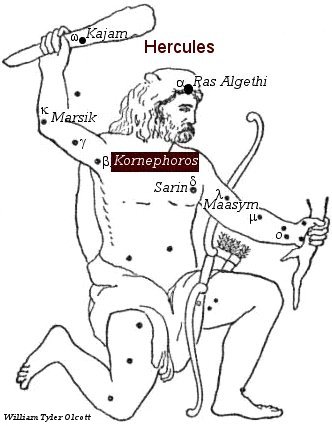| Fixed star: KORNEPHOROS | |
| Constellation: Beta (β) Hercules | |
| Longitude 1900: 29SCO42 | Longitude 2000: 01SAG05 |
| Declination 1900: +21.42′ | Declination 2000: +21.29′ |
| Right ascension: 16h 30m | Latitude: +42.42′ |
| Spectral class: G8 | Magnitude: 2.8 |
The history of the star: Kornephoros
from p.243 of Star Names, Richard Hinckley Allen, 1889.
[A scanned copy can be viewed on this webpage

Korneforos and Kornephoros are from the Greek Korunephoros which we have seen applied to the whole figure of the constellation Hercules. Burritt’s Atlas of 1856 has KornephorusvelRutilicus, {p.244} perhaps the diminutive of rutilus, “golden red,” or “glittering,” an adjective applied to Arcturus; but this term is by no means appropriate for beta (β Kornephoros). The AraboLatin Almagest of 1515 reads rutillico, adding propinque cillitico, this last unintelligible unless explained by the Basel edition of 1551 as penes axillam seu scapulam; so that we may perhaps consider the alternative title to be from the barbarism used to show the star’s position on the shoulder of the figure. Indeed, the 17th century German astronomer Bayer said of it, Rutilicum barbari dicunt. The German astronomer Ideler (1766-1846), however, asserted his belief that it was from rutellum, the diminutive of rutrum, a sharp instrument of husbandry or war, in Roman times, that Hercules in some early representations, especially on the Arabic globes, is carrying. The Century Cyclopedia gives Rutilico as a rarely used name.
{p.244} beta (β Kornephoros) was the Chinese Ho Chung, In the River, while the 4th-magnitude gamma (γ) was Ho Keen, Between the River.
Star Names, Their Lore and Meaning, Richard Hinckley Allen, 1889].
The astrological influences of the constellation Hercules
Legend: This constellation was put in heaven as a reminder of the labors of Hercules. According to another account, however, during the war between the Gods and Titans the former all ran to one side of the heavens, which would have fallen had not Atlas and Hercules supported it, and the latter was placed in the sky in commemoration of this service. [Robson, p.46-47.]
Influences: According to Ptolemy it is like Mercury. It is said to give strength of character, tenacity and fixity of purpose, an ardent nature and dangerous passions. By the Kabalists it is associated with the Hebrew letter Daleth and the fourth Tarot Trump “The Emperor”. [Robson, p.47.]
The astrological influences of the constellation Hercules given by Manilius:
“Manilius associates Hercules with tightrope walking (funambulism):
Hercules, the figure on bended knee and called by the Greek name of Engonasin, about whose origin no certainty prevails. Of this constellation is begotten the desertion, craftiness, and deceit characteristic of its children, and from it comes the thug who terrorizes the heart of the city. If perchance his mind is moved to consider a profession, Engonasin [a Greek title for constellation Hercules meaning Kneeler] will inspire him with enthusiasm for risky callings, with danger the price, for which he will sell his talents: daring narrow steps on a path without thickness, he will plant firm feet on a horizontal tightrope; then, as he attempts an upward route to heaven, (on a sloping tightrope) he will all but lose his footing and, suspended in mid-air, he will keep a multitude in suspense upon himself” [Manilius, Astronomica, 1st century, AD, p.353.]
References:
Fixed Stars and Constellations in Astrology, Vivian E. Robson, 1923].